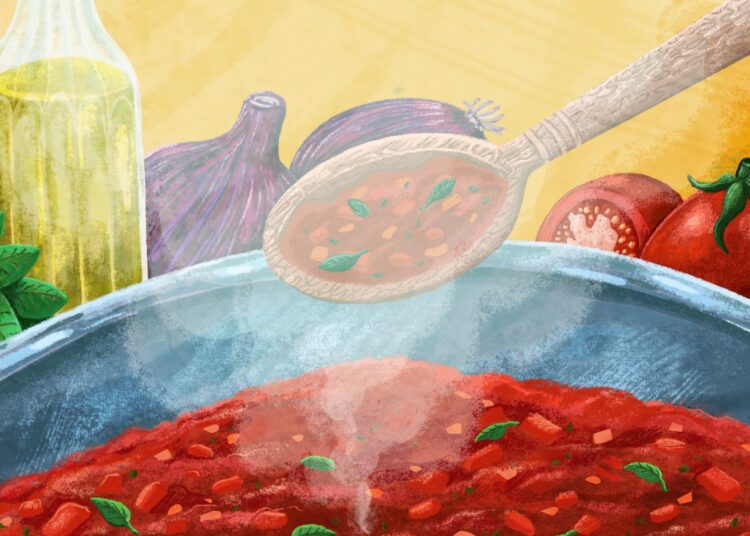Lily Fossett
Jarred tomato sauce just can’t compete with homemade
The first time I tasted anything close to a Sunday sauce — that Italian-American icon, a meaty tomato sauce that simmers on the hob all day — I was 14 years old, and it was in a lasagna cooked by my friend’s sister-in-law. Neither she nor I are Italian: We lived in Karachi at the time, and the recipe in question was from a well-loved stained photocopied page that likely came from an old Australian cookbook, given the quick-mix lamington recipe next to it. But that rich ragu erased all memory of sauces prior, and drove me down a rabbit hole to cook the perfect tomato sauce: At the time, there was no Google and my mum’s cookbook shelf only stacked some old American and British imprints. So I just ran with “the” Aussie sauce recipe, making it many, many times over, in different iterations.
There was one version of the sauce that stuck for a while, packed with far too much heat thanks to my generous heaps of garlic, ginger, and Pakistani chili powder. It was a crowd pleaser, but unfortunately, it also utilized cold-storage tomatoes that cost their weight in gold due to a shortage in Pakistan in the late ’90s. Now that I’m based in Washington, D.C., I’ve moved on to a sauce that embraces what would be considered more “traditional,” the flavors that I tasted across Italy. Hi, Calabrian chile flakes. Hi, San Marzano tomatoes. Hello, basil.
Because even if tomatoes are hard to come by, making tomato sauce from scratch is always worth it. “I am never ever going to use jarred sauce in my house, because for me, it doesn’t taste delicious,” says Matt Adler, the chef behind D.C. red-sauce joint Caruso’s Grocery. “[Jarred sauce] tastes like old onions, old garlic, and old basil. And I can never get away from those flavors.”
A good homemade tomato sauce centers brightness, a gentle acidity rounded off by the sweetness of a tomato — and is ideally untouched by onions and too much dried oregano. Good sauce, according to the experts, ultimately boils down to good tomatoes, really good tomatoes, good olive oil, and some simple ingredients. Because despite the belief that any legit sauce has to simmer for hours — and truthfully, who has time for that? — pros say that’s not necessarily the case.
“For me, there’s three different avenues of tomato sauce,” Adler says. “There’s pomodoro sauce, which is a quick cook with really good quality fresh tomatoes, or canned tomatoes cooked in extra virgin olive oil with garlic, and basil, a little bit of salt. That’s really fast. Then there’s an Italian-American marinara that’s going to cook probably for about two to two-and-a-half hours with onions, dried herbs, and fresh herbs in it.”
The third type is the classic Sunday ragu that’s become a default reference to “tomato sauce.” “I think a lot of people probably have in their head that if they’re gonna make sauce at home, they have to make that five-hour, six-hour Sunday ragu,” Adler says. But the pros all have an under-five-minutes iteration of it.
Of course, it all starts with the tomato. “You can get good fresh tomatoes in the U.S. if it’s summer,” says chef Anthony Mangieri of Una Pizza Napoletana in New York. “If you can’t, get a DOP San Marzano,” or look for canned California tomatoes like Bianco Dinapoli or Stanislaus. “For me, I drain all the liquid [from the can]. I never use that to cook with — all the people I buy from laugh at me from draining all the product,” Mangieri says. He suggests a fairly straightforward recipe of heating up garlic in olive oil before adding pepperoncini, dried oregano, fresh basil, and the crushed tomatoes. Once it’s bubbling, it’s off the hob and done, finished with sea salt.
Adler has a similar process: “It needs to be even quicker when making a fresh tomato sauce — like five minutes.” He simply toasts garlic, basil, and “classic good quality” chile flakes in olive oil before tossing in the chopped pomodoros — no need to peel, ever — “a splash of white wine, maybe a little sugar if needed, salt, and cooking it down for a few minutes before adding a pad of butter and pasta.”
If that still seems like too much work, go the way of Soung Wiser, of the Little Grand in D.C. “When you’re in season, literally all you need are tomatoes, garlic, and olive oil,” Soung says. “One of my favorite things is not even cooking any of that, just letting the tomatoes break down with salt and olive oil. Ultimately it’s just the ingredients: It’s having good tomatoes and good olive oil.”
I now have the privilege of being picky about my tomatoes. On a recent online dive into Pakistan’s agrarian journey, I came across a document from the 1990s co-authored by the U.S. Agency for International Development and the Pakistani government on possible foreign investment into Pakistani tomatoes. Back then, Pakistan’s poor global image and tense ties with the U.S. meant no significant investor was interested. But because my tomato sauce odyssey began with the most expensive, horrid cold storage tomatoes, the idea that Pakistani farmers were once on the precipice of becoming prominent tomato exporters was hard for me to comprehend.
All that has only resulted in my having greater respect for the fruit. I now find it therapeutic to watch tomatoes slathered with olive oil wither in stop motion in a low-temp oven — the product of my own not-that-hard work, not from a jar.
Halima Mansoor is a breaking news editor who sees the kitchen as a revolutionary space. In addition to documenting food, she is on a mission to trace her food heritage, explore immigrant cuisine, and initiate more people into the Marmite club.
Lily Fossett is a freelance illustrator based in Bath, U.K. She has a passion for portraying narrative in her illustrations and uses digital media to explore color and texture.














